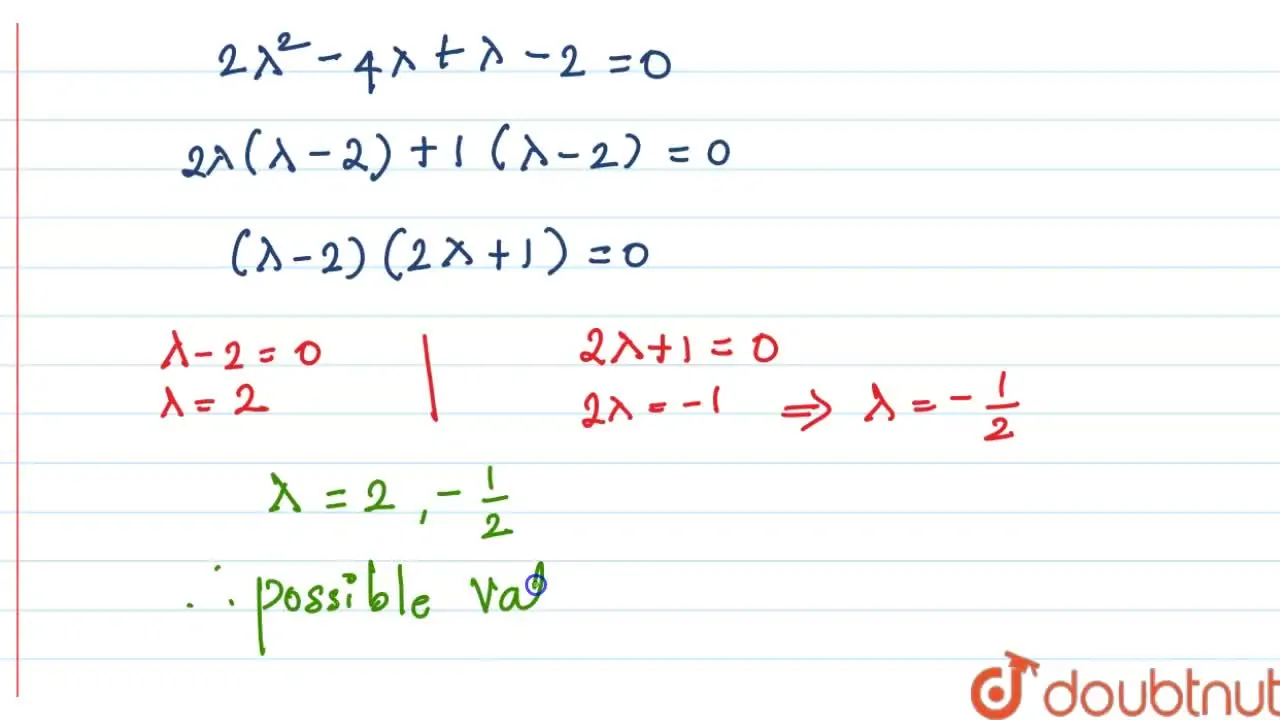If the point (λ+1,1),(2λ+1,3 and (2λ+2,2λ) are collinear then the possible value of λ is Solution in Tamil
The correct Answer is:a→q;b→r,s;c⊤;dtop
a. I1=∫π/3π/6sec2θf(2sinθ)dθ
Applying property ∫baf(a+b−x)dx=∫baf(x)dx
I1=∫π/3π/6sec2(π2−θ)f(2sin2(π2−θ))dθ
=∫π/3π/6cosec3θf(2sin2θ)dθ=I2
b. f(x+1)=f(x+3) or f(x)=f(x+2)
Thus, f(x) is periodic with period 2.
Then ∫a+baf(x)dx is independent of a for which b is multiple of 2.
Thus, b=2,4,6...........
c. Let I=∫41tan−1[x2]tan−1[x2]+tan−1[25+x2−10x].............1
Appling ∫baf(x)dx=∫baf(a+b−x)dx, we get
I=∫41tan[(5−x)2]tan−1[(5−x)2]+tan−1[x2]dx.............2
Adding equatiions 1 and 2 we get
2I=∫41dx or 2I=3 or I=3/2
d. Lety=√x+√x+√x+..............=√x+y
or y2−y−x=0
or y=1±√1+4x2.1=1+√1+4x2(∵y>1)
∴I=∫201+√1+4x2dx
=⎡⎣x2+(1+4x)3/232×2×4⎤⎦20
=[(1+2712)=(0+112)]
=1+2612=196
∴[I]=3
[I]=3
Related Playlists
- BOOK - CENGAGECHAPTER - DEFINITE INTEGRATION EXERCISE - Exercise (Numerical)28videos
DEFINITE INTEGRATION
- BOOK - CENGAGECHAPTER - DEFINITE INTEGRATION EXERCISE - JEE Main Previous Year12videos
DEFINITE INTEGRATION
- BOOK - CENGAGECHAPTER - DEFINITE INTEGRATION EXERCISE - Exercise (Comprehension)31videos
DEFINITE INTEGRATION
- BOOK - CENGAGECHAPTER - CURVE TRACINGEXERCISE - Exercise24videos
CURVE TRACING
- BOOK - CENGAGECHAPTER - DETERMINANTEXERCISE - Multiple Correct Answer5videos
DETERMINANT
Similar Questions
Ifthevalueof(lim)n→∞(n−32).∑6nj=1√jisequa<o√N,then the value of N12 is __________
02:31View Solution∫π0[cotx]dx, where [.] denotes the greatest integer function, is equal to
02:33View Solutiony=f(x) satisfies the relation ∫x2f(t)dt=x22+∫2xt2f(t)dt
The range of y=f(x) is02:36View SolutionDraw the graph of y=sin2x−cosx
03:30View Solutionconsider the fourth -degree polynomial equation
∣∣ ∣ ∣∣a1+b1xa1x2+b1c1a2+b2x2a2x2+b2c2a3+b3x2a3x2+b3c3∣∣ ∣ ∣∣=0
Without expanding the determinant find all the roots of the equation.03:27View SolutionThe points (a+1,1),(2a+1,3) and (2a+2,2a) are collinear if
03:43View Solution4x2+4√3x+λ=0యొక్క మూలాలు, సమానాలెడే λ=....
04:10View SolutionThe points with position vectors →x+→y,→x−→yand→x+λ→y are collinear for all real values of λ.
02:54View SolutionIf λ 1 and λ 2 are the wavelengths of the third member of Lyman and first member of the Paschen series respectively,then the value of λ 1 : λ 2 is
06:47View SolutionFind the value of λ so that the three vectors are co-planar. (2,-1,1), (1,2,-3) and (3,λ,5)
03:40View SolutionIf lambda_(1) and lambda_(2) are the wavelengths of the third member of Lyman and first member of the Paschen series respectively,then the value of λ 1 : λ 2 is:
01:39View SolutionThe points (a+1,1),(2a+1,3) and (2a+2,2a) are collinear if
01:22View SolutionIf one root of the equation 6x^2 − 2 x + ( λ − 5 ) = 0 be the reciprocal of the other, then λ =
01:56View SolutionThe points (a+1,1),(2a+1,3) and (2a+2,2a) are collinear if
01:06View SolutionThe points (a+1,1),(2a+1,3) and (2a+2,2a) are collinear if
01:10View Solution


